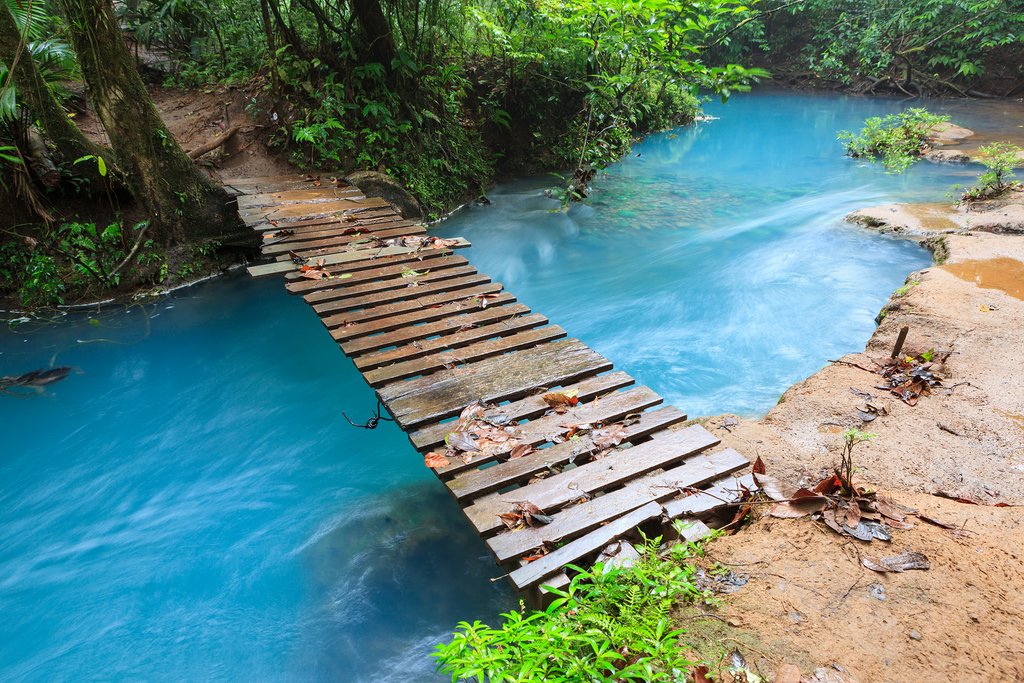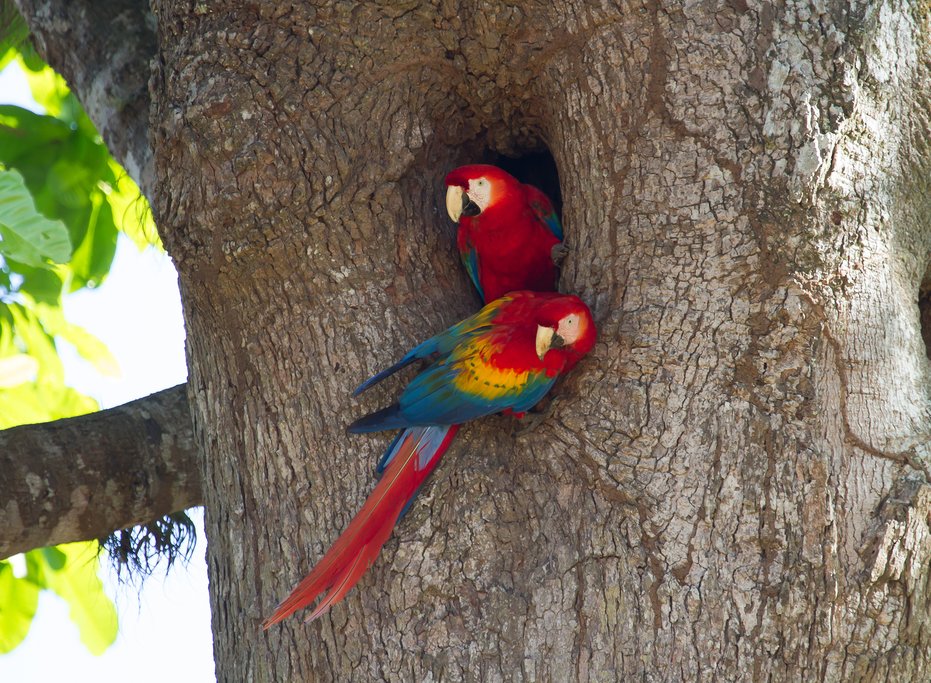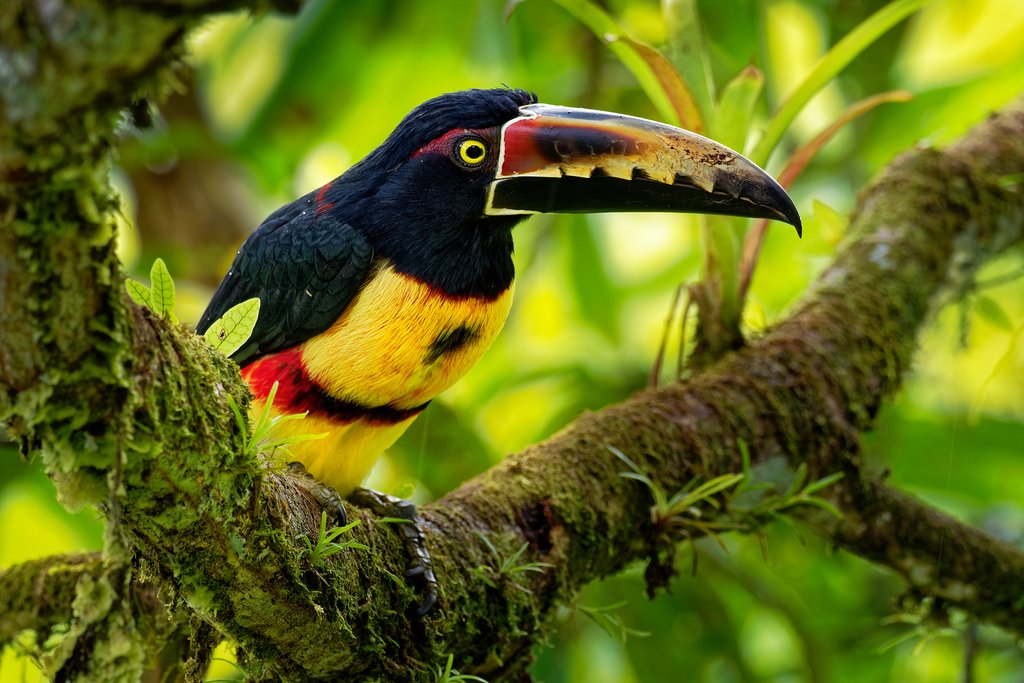Highlights
- Go birding in Costa Rica's most exotic national parks
- View rare bird species in the wetlands of the Caño Negro Wildlife Refuge
- Hike near the sky-blue waters of the Celeste River
- Tour the botanical gardens of Las Cruces Biological Station
- Search for the elusive resplendent quetzal in the Talamanca Mountains
Brief Itinerary
| Day | Highlights | Overnight |
|---|---|---|
| Day 1 | Arrive in Costa Rica - Experience San José's Culture and History | San Jose |
| Day 2 | Birding at Vara Blanca - Transfer to La Fortuna/Arenal | Arenal/La Fortuna |
| Day 3 | Birding Tour Near Arenal Observatory Lodge | Arenal/La Fortuna |
| Day 4 | Arenal to Caño Negro | Caño Negro |
| Day 5 | Early-Morning Birding at Caño Negro | Caño Negro |
| Day 6 | Caño Negro to the Celeste River & Tenorio National Park | Cañas |
| Day 7 | Travel to Rincón de la Vieja National Park | Cañas |
| Day 8 | Palo Verde National Park - Travel to Tárcoles | Tarcoles |
| Day 9 | Birding at Villa Lapas - Optional Visit to Carara National Park | Tarcoles |
| Day 10 | Tárcoles to the Southern Pacific Coast | La Gamba |
| Day 11 | Early Birding on the Southern Pacific Coast | La Gamba |
| Day 12 | Las Cruces Biological Station | Las Cruces |
| Day 13 | Las Cruces to the Talamanca Mountains | San Gerardo de Dota |
| Day 14 | Quetzal Safari in Los Quetzales National Park | San Gerardo de Dota |
| Day 15 | San Gerardo to San José - Departure |
Detailed Itinerary
Day 1: Arrive in Costa Rica - Experience San José's Culture and History

Welcome to Costa Rica, the land of pura vida! After arriving at Juan Santamaría International Airport in San José, a local representative will meet you and escort you to your hotel. The rest of the day you'll have free to explore the city at your leisure.
Perhaps take a stroll through Mercado Central (Central Market), which features over 200 shops, food stalls, and sodas (traditional restaurants). Then visit the Catedral Metropolitana (Metropolitan Church), whose interior combines Greek Orthodox, neoclassical, and Baroque styles. There's also a pair of popular museums in San José: Museo del Oro Precolumbino (Pre-Columbian Gold Museum), and Museo del Jade, which houses the world's largest collection of pre-Columbian jade artifacts.
Be sure to explore Barrio Amón, a bohemian neighborhood home to historic cafetalero (coffee grower) mansions built during the late 19th and early 20th centuries. For dinner, opt for a restaurant in the hills of Escazú. This elevated region on the western edge of the city offers panoramic views of the valley below. That said, San José is filled with great restaurants serving everything from traditional Costa Rican fare to forward-thinking fusion cuisine.
Day 2: Birding at Vara Blanca - Transfer to La Fortuna/Arenal

After breakfast at your hotel, you'll meet your English-speaking guide and embark on a great Costa Rica birding adventure. The first stop is the highland village of Vara Blanca, which is located just north of San José, on the Continental Divide between the volcanoes of Poás and Barva. All told, you'll spend about 1.5 hours enjoying some fantastic birding outside of the village. Common varieties include the fiery-throated hummingbird, barred hawk, ornate hawk-eagle, chestnut-mandibled toucan, tanager, and flycatcher.
Afterward, you'll drive north two hours to the town of La Fortuna, the gateway to Arenal Volcano National Park. You won't miss the namesake volcano—Arenal juts 5,479 feet (1,670 meters) out of the ground like an arrowhead. Upon arrival, you'll check into the Arenal Observatory Lodge, which sits on 870 acres of rainforest with its own bird sanctuary home to around 500 species. The prime vantage point is a 92-foot (28-meter) tower where you can observe birds like herons, trogons, and red-lored parrots.
For dinner, you can dine on Costa Rican and international cuisine at the Arenal Observatory Restaurant, which offers its own stunning views of Lake Arenal.
Day 3: Birding Tour Near Arenal Observatory Lodge

Arenal Observatory Lodge & Spa is a gateway to Costa Rican birdlife. Half of all birds in the country (more than 500 species) have been spotted in the region around the lodge. These include the black-crested coquette, lovely cotinga, yellow-eared toucanet, bare-necked umbrella bird, emerald tanager, great curassow, thicket antpitta, ornate hawk-eagle, and the fasciated tiger-heron.
Today, accompanied by an experienced guide, you'll embark on one of the following birds tours in the region:
- Observatory Lodge Birding Tour: This two-hour morning birding tour takes place in the 870 acres of protected area around the lodge. Listen for the calls of toucans, trogons, and tanagers, which are common sights. If you're lucky you might even spot the elusive umbrella bird, known for its stylish pompadour hairdo.
- Hanging Bridges Tour: This six-hour tour gives you a birds-eye-view (literally) of your avian subjects by visiting the nearby Mistico Arenal Hanging Bridges Park. This protected area has an approximately 1.9-mile network of suspension bridges in prime birding territory (over 350 species have been spotted) between the Tilarán and Guanacaste mountain ranges.
- Reserva Mirador el Silencio Tour: This is a four-hour tour of a private reserve sitting on nearly 250 acres of primary and secondary rainforest. It features seven trails winding around the base of Arenal Volcano where at various points you can view many species of exotic birds like toucans, parrots, hummingbirds, and woodpeckers.
Day 4: Arenal to Caño Negro

In the morning you'll transfer 2.5 hours to the far north of the country, stopping at times to take birding breaks at ideal vantage points. Today's destination is the Caño Negro Wildlife Refuge, which, comprising 24,612 acres (9,960 hectares), is the largest wetland in the country. Within its boundaries are lagoons, rivers, rainforest, and tiny villages, making it ideal birding territory as the area lies in a key migratory route for northern birds.
Upon arrival, you'll check-in to your eco-lodge and then head out and explore. There's good birding around the property, as it features dense bushes and tall trees amid secondary rainforest. These conditions attract many species like the spot-breasted wren, greenish elaenia, cinnamon woodpecker, yellow-throated euphonia, red-legged honeycreeper, black-cheeked woodpecker, and red-lored parrot, to name a few.
Day 5: Early-Morning Birding at Caño Negro

Today you'll enjoy one of the most exciting birding tours in the country. The Caño Negro Wildlife Refuge is known for its incredible diversity of resident birds as well as being the winter home for thousands of returning migratory birds. On this tour, you'll observe many species found only in this unique ecosystem.
Some birds you can spot include kingfishers, cormorants, anhingas ("snakebird"), southern lapwings, black-bellied whistling-ducks, black-necked stilts, purple gallinules, russet-naped wood-rails, yellow-breasted crakes, black-collared hawks, lesser yellow-headed vultures, snail kites, bat falcons, agami herons, little blue herons, great egrets, tricolored herons, boat-billed herons, and many others.
This is a three-hour tour accompanied by a local guide who will lead you to the best vantage points. After the tour, you'll return to your hotel. Since you'll have the afternoon free, you can choose between a number of other tours/activities in the Caño Negro Wildlife Refuge such as a wetlands boat tour, sport-fishing excursion, or nocturnal nature walk.
Chat with a local specialist who can help organize your trip.
Day 6: Caño Negro to the Celeste River & Tenorio National Park

In the morning, you'll leave the northern plains and travel southwest toward the Pacific coast, stopping along the way at the Rio Celeste and Tenorio National Park. The road heading into the national park offers good birding, as it's home to various species like the lovely cotinga, black hawk-eagle, white-fronted nunbird, keel-billed motmot, sunbittern, yellow-eared toucanet, and the lattice-tailed trogon.
Then you'll visit one of the most incredible sights in the country: the sky blue Río Celeste, located inside the park. Local legend has it that after God was done painting the sky he washed his paintbrushes in this river, hence the name, which translates to "river of the sky." The scientific explanation says the vivid blue color is due to a mixture of sulfur and carbonate, which originates in the dormant Tenorio Volcano.
You'll embark on a four-mile (seven-kilometer) hike on a trail that runs along the Celeste, passing many sites of interest like the river's famous waterfall and the Blue Lagoon, a natural turquoise pool. Later, you'll stop at a viewpoint with vistas of the Tenorio Volcano. But it's not just incredible landscapes you'll enjoy; Tenorio National Park is a great birding destination too. Here you'll find species like the violaceous quail-dove, black-eared wood-quail, rufous-vented ground-cuckoo, and more.
Day 7: Travel to Rincón de la Vieja National Park

With your guide, you'll drive a little over an hour northwest from the hacienda to Rincón de la Vieja National Park. Spread over 34,000 acres, this protected area is home to tropical forest, cascading waterfalls, natural hot springs, dozens of rivers, and two volcanoes. The many hiking trails here attract travelers year-round, and this includes bird lovers. After checking into your hotel, you can head into the park and do some birding.
Multitudes of bird species are found here, as the dense canopy of laurel trees provide the ideal avian habitat. Some of the most colorful examples include emerald toucanet, motmots, turkey vultures, red-billed pigeons, white-fronted parrots, keel-billed toucans, northern-barred woodcreepers, and more. Rare and exotic mammals found in the area include kinkajous, pumas, a variety of monkeys, sloths, tapirs, and jaguars.
Day 8: Palo Verde National Park - Travel to Tárcoles

After breakfast, you and your guide will transfer 45 minutes south to Palo Verde National Park. This large protected area (some 49,000 acres) is unique in that it's home to both tropical dry forest as well as wetlands. Before entering the park there are rice fields where you'll find good concentrations of wood storks. Also here are the black-necked stilt, great egret, and solitary sandpiper. During the migratory months, you'll see bobolinks, dickcissels, and many more species.
Once inside the park, you can view an even greater variety of exotic specimens. There's the thicket tinamou, fulvous whistling duck, northern shoveler, least bittern, glossy ibis, jabiru, hook-billed kite, northern harrier, white-tailed hawk, mangrove cuckoo, and the scrub euphonia. After birding, you'll continue to the central Pacific coast and the town of Tárcoles. Sitting on the banks of the river of the same name, Tárcoles is known for its scarlet macaws and giant crocodiles.
Day 9: Birding at Villa Lapas - Optional Visit to Carara National Park

Accompanied by your guide, you'll embark on a birding tour along the trails around Hotel Villa Lapas. This hotel sits on almost 500 acres of land that abounds with exotic birds. Interesting species here include the chestnut-mandibled toucan, fiery-billed aracari, pale-billed woodpecker, and various types of trogons (slaty-tailed, gartered, black-headed, etc.). Plus, groups of scarlet macaws often fly overhead, especially in the early morning and late afternoon.
The forest trail behind the hotel is also worth visiting as there's a good chance of spotting the long-tailed manakin, a colorful bird that performs choreographed dances to attract females. After the tour, we recommend visiting Carara National Park. This protected area spans 12,900 acres and includes both tropical dry scrub as well as southern Pacific rainforest, which makes it home to a wide variety of flora and fauna. Some 360 of birds call this area home, including the scarlet macaw.
Day 10: Tárcoles to the Southern Pacific Coast

In the morning you'll drive four hours south to the Esquinas Rainforest Lodge. The scenery on this coastal trip is gorgeous as you'll drive alongside miles of unspoiled beaches and beautiful bays. When you arrive at the village of La Gamba, it's only another three miles to the lodge, which is hidden in the jungles of Piedras Blancas National Park. This area is a hot spot for birders interested in a more remote rainforest experience than what is commonly found in many other parts of the country.
Because Piedras Blancas is so close to the Osa Peninsula and Corcovado National Park, you can expect the same high levels of biodiversity in the jungles around the lodge. Esquinas offers a variety of tours and excursions beyond birding such as hiking, horseback riding, and kayak tours at the nearby Golfo Dulce ("Sweet Gulf").
Day 11: Early Birding on the Southern Pacific Coast

Another great birding tour awaits in the form of a two-hour hike. With an experienced local guide, you'll walk forest trails, across pastureland, and along rivers in the Golfo Dulce region. There are a number of exotic species in the area, including trogons, motmots, woodpeckers, manakins, curassows, flycatchers, and the famous black-cheeked ant tanager. Animals often sighted around the trail include agoutis, coatis, basilisks, and caimans. The hike departs around 6 am and returns in time for breakfast.
If you want to combine your bird tour with other activities later in the day, here are some recommendations:
- Day Hike: The area around the Esquinas Rainforest Lodge is categorized as lowland tropical wet forest and contains the highest density of trees (about 100 per acre) in Costa Rica. It's also diverse, as here you'll find a total of 2,500 species of plants. The network of trails around the lodge features easy hikes through secondary forest as well as longer, more challenging trails leading through unspoiled primary rainforest.
- Nocturnal Wildlife Tour: This brisk hike starts after dinner and allows you to experience the forest by night. A local guide will take you through the lodge gardens and along the Quebrada Negra rainforest stream. Nocturnal wildlife you can see here includes snakes, frogs/toads, bats, owls, and spiders.
- Golfo Dulce Tour and Casa Orquideas Botanical Garden: On this three-hour tour, a motorboat will take you along the little-inhabited coast of the Golfo Dulce. Keep a lookout on the drive as there is a good chance of seeing dolphins frolicking offshore. After an hour, you'll reach Casa Orquídea, an ornately landscaped tropical garden abounding with hundreds of species of ornamental plants. After a guided tour there will be time for swimming on the beach and a picnic lunch.
Day 12: Las Cruces Biological Station

Enjoy one last morning birding excursion around the gardens of the Esquinas Rainforest Lodge. Afterward, accompanied by your guide, you'll drive about an hour to Las Cruces Biological Station, a research facility/botanical garden located in the mountains of southeastern Punta Arenas Province. On the drive there, you can make periodic stops to admire local birds.
Upon arrival at Las Cruces Biological Station, you'll tour its grounds. The property encompasses 657 acres of forest, which is home to hundreds of different bird species. Within the station lies the Robert and Catherine Wilson Botanical Garden, a 30-acre site that features various plants from around the world. These include exotic and colorful flora like bromeliads and heliconias. The station itself houses over 400 species of birds, 100 species of mammals, and 800 species of butterflies.
Day 13: Las Cruces to the Talamanca Mountains

The adventure continues as today you'll travel about four hours from Las Cruces to the Talamanca Mountains and the little town of San Gerardo de Dota. To break up the drive, on the way to San Gerardo you'll stop at San Isidro del General. This charming town is off the tourist trail and home to a massive farmers market with over 200 vendors selling every kind of fruit and vegetable you can imagine. It's the perfect spot to pick up some delicious, exotic produce.
In the afternoon, you'll reach San Gerardo de Dota, which is situated near the Río Savegre in the cloud forests of the Talamanca Mountains. It's another little-known town, but the few who do come here usually do so for one compelling reason. The oak forests in the area are the natural habitat of one of the most beautiful birds in the world: the resplendent quetzal.
After checking into your hotel, you can spend the remainder of the day relaxing. Due to the remote location of the town, we recommend enjoying dinner at your hotel. Be sure to save your energy and get to bed early, because in the morning you'll go searching for the resplendent quetzal.
Day 14: Quetzal Safari in Los Quetzales National Park

The small town of San Gerardo de Dota sits next to a quiet road in the Talamanca Mountains. The main attraction here is Los Quetzales National Park, famous among birding enthusiasts as one of the best places to view the resplendent quetzal. With its vivid green and red plumage, it has an earned reputation as one of the world's most beautiful birds.
In the morning you'll embark on an early (5 am) birding tour in search of the resplendent quetzal. You stand a good chance of spotting one, as the cool climate in this higher-altitude region is attractive to the quetzal, as are the berries produced by the many aguacatillo trees here. With its metallic green plumage, crimson breast, and long, flowing tail feathers, watching a quetzal soar through the air is a unique and breathtaking experience.
After the tour, you'll go back to your hotel for breakfast, and then you'll have the rest of the day free. You can choose between a number of leisure activities, be it hiking the trails around the hotel, lazing by the pool, or simply relaxing on the restaurant patio with your binoculars and looking for more birds.
Day 15: San Gerardo to San José - Departure

Take the morning to enjoy one final breakfast in paradise. At the appropriate time, you and your guide will leave the Talamanca Mountains on a three-hour drive north to the airport in San José, where you'll catch your flight home. Come back soon!


